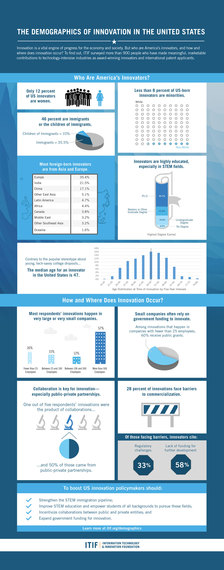(This post--which originally appeared on InnovationFiles.org -- was co-authored by Adams Nager, economic policy analyst at the Information Technology and Innovation Foundation.)
Behind every technological innovation is an individual or a team of individuals responsible for the hard scientific or engineering work. And behind each of them is an education and a set of experiences that impart the requisite knowledge, expertise, and opportunity. These scientists and engineers drive technological progress by creating innovative new products and services that raise incomes and improve quality of life for everyone.
But who are these individuals? How old are they? Were they born in the United States or abroad? Are they male or female? What are their races and ethnicities? What kind of education do they have?
To find out, ITIF surveyed more than 900 people who have made meaningful, marketable contributions to technology-intensive industries as award-winning innovators and international patent applicants. We learned that the demographics of U.S. innovation are different from the demographics of the country as a whole, and also from the demographics of college-educated Americans--even those with Ph.Ds. in science or engineering.
The study finds that immigrants comprise a large and vital component of U.S. innovation, with more than one-third of U.S. innovators (35.5 percent) born outside the United States. Alarmingly, women represent just 12 percent of U.S. innovators, and U.S.-born minorities (including Asian Americans, African Americans, Hispanics, Native Americans, and other ethnicities) represent just 8 percent of U.S.-born innovators.
Contrary to popular conceptions about precocious college dropouts with big ideas, U.S. innovators actually tend to be experienced and highly educated--and most hold advanced degrees in the fields of science and technology. Another finding that may surprise some is the fact that approximately 60 percent of private-sector innovations originate from businesses with more than 500 employees.
Perhaps less surprising: The study finds that innovation occurs all across the United States, but concentrates in the Northeast, in California, and in areas near national laboratories and other sources of public research spending. Survey respondents cite insufficient funds, market factors, and regulatory constraints as barriers to commercialization.
The clearest conclusions we draw from this study are that to boost U.S. innovation, policymakers should broaden and deepen the national pool of STEM talent by improving STEM education and empowering students of all backgrounds to pursue these fields, and by strengthening the pipeline for immigrant scientists and engineers to work in the United States.

